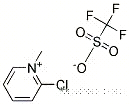84030-18-2Relevant articles and documents
Synthesis of new Pro-PYE ligands as co-catalysts toward Pd-catalyzed Heck-Mizoroki cross coupling reactions
Munir, Naima,Masood, Sara,Liaqat, Faroha,Tahir, Muhammad Nawaz,Yousuf, Sammer,Kalsoom, Saima,Mughal, Ehsan Ullah,Sumrra, Sajjad Hussain,Maalik, Aneela,Zafar, Muhammad Naveed
, p. 37986 - 38000 (2019/12/03)
The present research work describes the synthesis of five new ligands containing pyridinium amine, [H2L1][OTf]2-[H2L5][I]2 from two new precursors, [P3Et][I] and [P2Me][CF3SO3]. The structure elucidations of the compounds were confirmed by multinuclear NMR (1H, 13C), FT-IR and by single crystal XRD techniques. Theoretical DFT studies were carried out to get better insight into the electronic levels and structural features of all the molecules. These synthesized new Pro-PYE ligands [H2L1][OTf]2-[H2L5][I]2 were found to be significantly active as co-catalysts for Pd(CH3CO2)2 toward Heck-Mizoroki coupling reactions with wide substrate scope in the order of [H2L1][OTf]2 ? [H2L2][OTf]2 > [H2L3][OTf]2 > [H2L4][OTf]2 > [H2L5][I]2.
Pyridine-derived N-heterocyclic carbenes: An experimental and theoretical evaluation of the bonding in and reactivity of selected normal and abnormal complexes of nickel(II) and palladium(II)
Stander-Grobler, Elzet,Schuster, Oliver,Heydenrych, Greta,Cronje, Stephanie,Tosh, Evangeline,Albrecht, Martin,Frenking, Gernot,Raubenheimer, Helgard G.
experimental part, p. 5821 - 5833 (2011/02/22)
We report a thorough investigation of a series of isomeric complexes with the general formula trans-(pyridylidene)M(PPh3)2Cl (M = Pd, Ni). For the first time, a systematic comparison of normal, abnormal, and remote bonding modes is presented. X-ray structural and 13C NMR data indicate the importance of carbenoid mesomeric contributions in their compound class. The catalytic performance of the palladium complexes trans-(pyridylidene) Pd(PPh3)2Cl as precursors in Suzuki-Miyaura-type cross-coupling suggests a correlation of remote bonding with catalyst robustness and effectivity. When metal precursors M(PPh3)4 are reacted with 2,4-dichloropyridinium salts, preferential formation of remote carbene complexes occurs and indications are that electronic parameters rather than steric influences are responsible for the observed selectivity. Calculations at the BP86/TZ2P level of theory support interpretation of the results.
Synthesis of carbacephems from serine
Folmer, James J.,Acero, Carles,Thai, Dung L.,Rapoport, Henry
, p. 8170 - 8182 (2007/10/03)
Carbacephems have been synthesized from D-serine by two routes involving construction first of the six-membered ring followed by cyclization to give the bicyclic β-lactam. In one route, alkylation of a lactim ether was accomplished with Ni(Acac)2 as a catalyst. The desired R stereochemistry at the carbon corresponding to C-6 of the cephem was obtained by stereospecific hydrogenation of a vinylogous carbamate. The second route involved a stereospecific Michael cyclization to give the same C-6 stereochemistry. Closure of a piperidyl β-amino acid intermediate common to both routes was accomplished using a modified Mukaiyama reagent found to be superior in our system to the traditional reagent. The resulting carbacephem core was stereospecifically substituted at C-7 with an ethyl or amino functionality. The ethylated intermediate was transformed into a stable enol triflate useful for the further elaboration of biologically important carbacephems.


